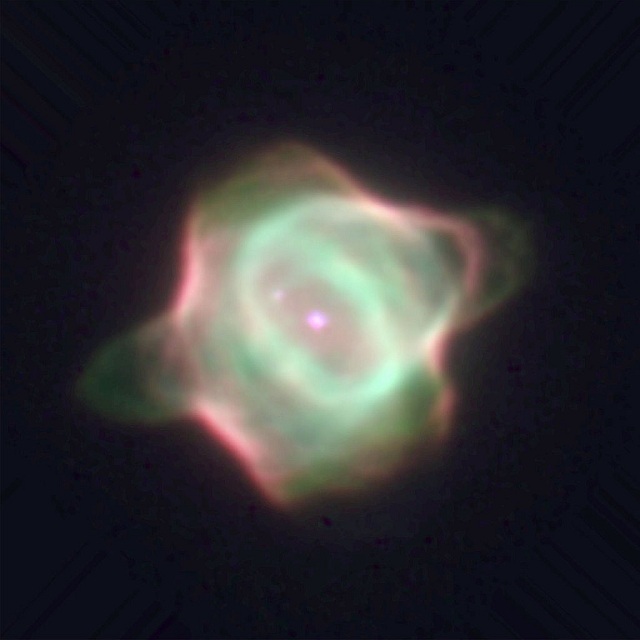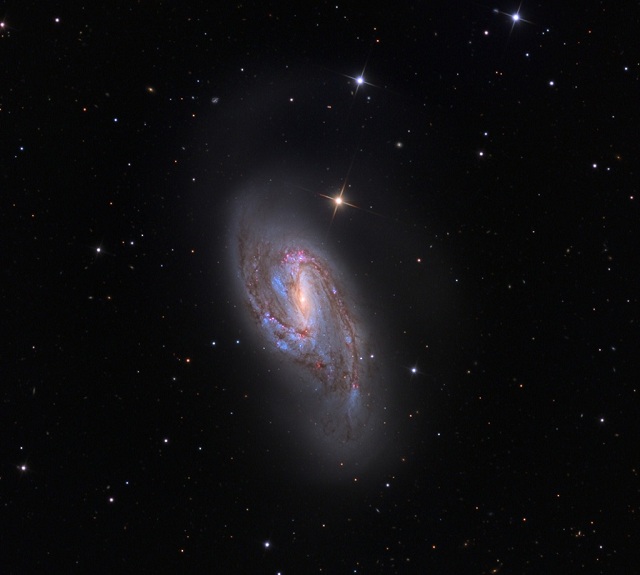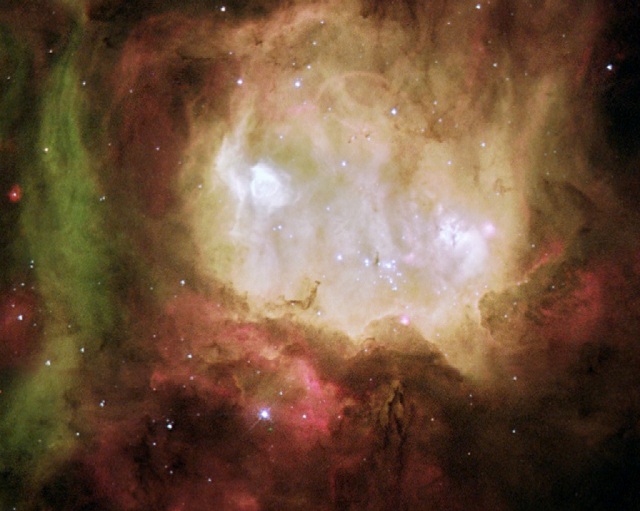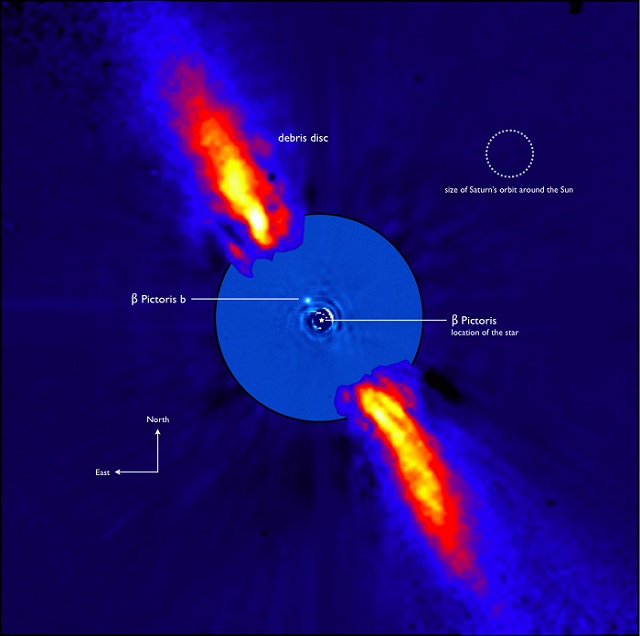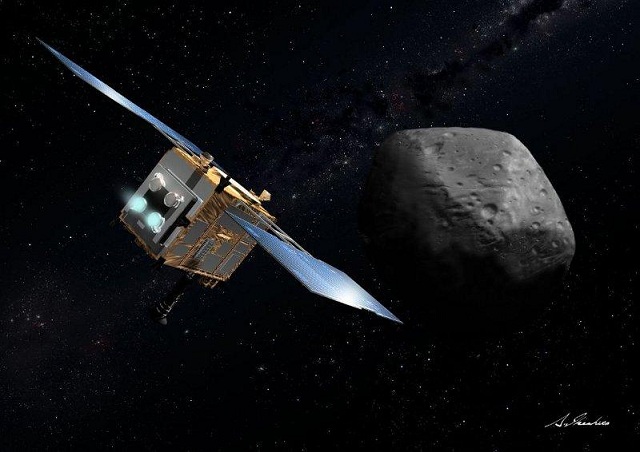
Posts by AnneliesRhemrev:
Anne’s Image of the Day: The Stingray Nebula
October 13th, 2012By Annelies Rhemrev
October 13, 2012
The Stingray Nebula, a young planetary nebula in Ara
Image Credit: Matt Bobrowsky, Orbital Sciences Corporation and NASA/ESA
For a larger image click here.
The Stingray Nebula (designated Henize 1357, Hen 3-1357) is the youngest known planetary nebula, located about 18,000 light-years away in the southern constellation Ara. It has a relatively small size (some 0.16 light-year across, one-tenth the size of most other known planetary nebula). However, it is about 130 times larger than our Solar System and is continuously expanding. It is named the Stingray because its shape is similar to the catfish.
This nebula was created when a dying star (a supergiant) exhausted its shell of gases, and now shines like a neon light. This shell of gas is illuminated by the star remaining in the center of the nebula. As the nebula continues to move away from the star, the core of the star – which has become a white dwarf — is heated and illuminates the gas.
Forty years ago the Stingray nebula was still a protoplanetary nebula in which the gas had not yet become hot and ionized. It is now considered to be a planetary nebula, as its central star has warmed up long enough in the last 40 years to light the gases. Such young nebulae are found very rarely, because it takes 100 years for a dying star to turn into a visible planetary nebula, which means very little considering the life of a star. Typically, stars live for millions of years. This nebula will help astronomers to understand this short and still poorly known transition phase which leads to the formation of a new planetary nebula.
This image shows how the outer shells of gas are collimating the continuing outflow of gas from the central star — an important observation, as the process of how these outflows become collimated has not been well understood.
Stingray’s central white dwarf star faded by a factor of three between 1987 and 1995. Observations also revealed a companion to the white dwarf, seen diagonally above it at 10 o’clock in this image. Astronomers suspect that the companion account for the complex shapes and rings of this planetary nebula.
A spur of gas (green) is forming a faint bridge to the companion star due to gravitational attraction. The image also shows a ring of gas (green) surrounding the bright central white dwarf, with bubbles of gas to the lower left and upper right of the ring.
The wind of material propelled by radiation from the hot central star has created enough pressure to blow open holes in the ends of the bubbles, allowing gas to escape. The red curved lines represent bright gas that is heated by a “shock” caused when the central star’s wind hits the walls of the bubbles. The colors shown are actual colors emitted by nitrogen (red), oxygen (green), and hydrogen (blue).
Read more on Anne’s Astronomy News
The Girl’s Best Friend Found: A Big Diamond Planet
October 12th, 2012By Annelies Rhemrev
New research led by Yale University scientists suggests that a rocky planet twice Earth’s size orbiting a nearby star is a diamond planet.
 Family portraits of two planetary systems: A simulation of the silhouette of planet 55 Cancri e passing in front of its parent star, compared to the Earth and Jupiter transiting our Sun, as seen from outside the Solar System. Image Credit: Jason Rowe, NASA
Family portraits of two planetary systems: A simulation of the silhouette of planet 55 Cancri e passing in front of its parent star, compared to the Earth and Jupiter transiting our Sun, as seen from outside the Solar System. Image Credit: Jason Rowe, NASA
“This is our first glimpse of a rocky world with a fundamentally different chemistry from Earth,” said lead researcher Nikku Madhusudhan, a Yale postdoctoral researcher in physics and astronomy. “The surface of this planet is likely covered in graphite and diamond rather than water and granite.”
The paper reporting the findings, titled “A Possible Carbon-rich Interior in Super-Earth 55 Cancri e”, has been accepted for publication in the journal Astrophysical Journal Letters.
The planet — called 55 Cancri e — has a radius twice Earth’s, and a mass eight times greater, making it a “super-Earth.” It is one of five planets orbiting a Sun-like star, 55 Cancri, that is located 40 light years from Earth yet visible to the naked eye in the constellation of Cancer.
The planet orbits at hyper speed — its year lasts just 18 hours, in contrast to Earth’s 365 days. It is also blazingly hot, with a temperature of about 3,900 degrees Fahrenheit, researchers said, a far cry from a habitable world.

Illustration of the interior of 55 Cancri e — an extremely hot planet with a surface of mostly graphite surrounding a thick layer of diamond, below which is a layer of silicon-based minerals and a molten iron core at the center. Image Credit: Haven Giguere
The planet was first observed transiting its star last year, allowing astronomers to measure its radius for the first time. This new information, combined with the most recent estimate of its mass, allowed Madhusudhan and colleagues to infer its chemical composition using models of its interior and by computing all possible combinations of elements and compounds that would yield those specific characteristics.
Astronomers had previously reported that the host star has more carbon than oxygen, and Madhusudhan and colleagues confirmed that substantial amounts of carbon and silicon carbide, and a negligible amount of water ice, were available during the planet’s formation.
Astronomers also thought 55 Cancri e contained a substantial amount of super-heated water, based on the assumption that its chemical makeup was similar to Earth’s, Madhusudhan said. But the new research suggests the planet has no water at all, and appears to be composed primarily of carbon (as graphite and diamond), iron, silicon carbide, and, possibly, some silicates. The study estimates that at least a third of the planet’s mass — the equivalent of about three Earth masses — could be diamond.
“By contrast, Earth’s interior is rich in oxygen, but extremely poor in carbon — less than a part in thousand by mass,” says co-author and Yale geophysicist Kanani Lee.

Star map showing the planet-hosting star 55 Cancri in the constellation of Cancer. The star is visible to the naked eye, though better through binoculars. Image Credit: Nikku Madhusudhan; created using Sky Map Online
The identification of a carbon-rich super-Earth means that distant rocky planets can no longer be assumed to have chemical constituents, interiors, atmospheres, or biologies similar to those of Earth, Madhusudhan said. The discovery also opens new avenues for the study of geochemistry and geophysical processes in Earth-sized alien planets. A carbon-rich composition could influence the planet’s thermal evolution and plate tectonics, for example, with implications for volcanism, seismic activity, and mountain formation.
“Stars are simple — given a star’s mass and age, you know its basic structure and history,” said David Spergel, professor of astronomy and chair of astrophysical sciences at Princeton University, who is not a co-author of the study. “Planets are much more complex. This ‘diamond-rich super-Earth’ is likely just one example of the rich sets of discoveries that await us as we begin to explore planets around nearby stars.”
In 2011, Madhusudhan led the first discovery of a carbon-rich atmosphere in a distant gas giant planet, opening the possibility of long-theorized carbon-rich rocky planets (or “diamond planets”). The new research represents the first time that astronomers have identified a likely diamond planet around a Sun-like star and specified its chemical make-up. Follow-up observations of the planet’s atmosphere and additional estimates of the stellar composition would strengthen the findings about the planet’s chemical composition.
The authors of the paper are Madhusudhan, Lee, and Olivier Mousis, a planetary scientist at the Institut de Recherche en Astrophysique et Planetologie in Toulose, France.
Source: Yale University
Read more on Anne’s Astronomy News
Anne’s Image of the Day: Messier 66
October 12th, 2012By Annelies Rhemrev
October 12, 2012
Messier 66, an intermediate spiral galaxy in Leo
Image Credit & Copyright: Adam Block/Mount Lemmon SkyCenter/University of Arizona (http://www.caelumobservatory.com/index.html)
For a larger image click here.
Messier 66 (also known as NGC 3627 and Arp 16) is an intermediate spiral galaxy of some 95,000 light-years across. The galaxy is about 36 million light-years away in the constellation of Leo, and is moving away from us at 727 kilometers per second. It is the largest member of the famous Leo Triplet, a group of three interacting galaxies that include Messier 65 and NGC 3628.
Messier 66 has a well developed but not well defined central bulge. Its core and bar-like structure illustrates a concentration of older stars, and while the bar seems devoid of star formation, the bar ends are actively forming stars.
The prominent and unusual asymmetric spiral arms, laced with striking dust lanes and bright star clusters, are somewhat distorted. They seem to climb above the galaxy’s main disc and an apparently displaced nucleus.
This asymmetry is unusual; most often, dense waves of gas, dust and newly born stars wind about the galaxy’s centre in a symmetric way. Astronomers believe that Messier 66′s once orderly shape has most likely been distorted by the gravitational pull of its two neighbours.
Four supernovae have been observed in Messier 66: 1973R, 1989B, 1997bs and 2009hd.
Messier 66 is number 16 in Arp’s Atlas of Peculiar Galaxies, a catalogue of 338 peculiar galaxies produced by Halton Arp in 1966. Moreover, Arp assigned the number 317 to the Leo Triplett.
Read more on Anne’s Astronomy News
Surprising Spiral Structure Found Around Red Giant Star
October 11th, 2012By Annelies Rhemrev
Astronomers have discovered a totally unexpected spiral structure in space. The strange shape, discovered in gas and dust surrounding the red giant star R Sculptoris, was probably created by a hidden companion star orbiting the star. The research, which appears in the journal Nature this week, gives new insight on how stars like the Sun return material to space when they become old.
Observations using the Alma telescope have revealed an unexpected spiral structure in the material around the old star R Sculptoris. This feature has never been seen before, and is probably caused by a hidden companion star orbiting the star. This slice through the new Alma data reveals the shell around the star, which shows up as the outer circular ring, as well as a very clear spiral structure in the inner material. Image Credit: ALMA (ESO/NAOJ/NRAO)
The discovery was made by an international team of astronomers, among them several scientists from Chalmers University of Technology and Onsala Space Observatory. The team used the Atacama Large Millimeter/submillimeter Array (ALMA), the most powerful millimetre/submillimetre telescope in the world.
![The velocity and mass-loss rate evolution of the stellar wind around R[thinsp]Sculptoris.](http://www.nature.com/nature/journal/v490/n7419/carousel/nature11511-f3.2.jpg)

ALMA observes the Universe in radio waves: light which is invisible to our eyes. Extremely weak signals from space are collected by the ALMA antennas. Image Credit: ESO/B. Tafreshi
R Sculptoris is an example of an asymptotic giant branch (AGB) star. These are old stars which began their lives with masses between 0.8 and 8 solar masses. They are cool, red giants which lose mass in the form of strong stellar winds, and vary slowly but regularly in brightness. Their structure consists of a tiny central core of carbon and oxygen surrounded by a helium and hydrogen burning shell, and then an enormous convective envelope. The Sun will eventually evolve into an AGB star.
Read the paper in Nature:
http://www.nature.com/nature/journal/v490/n7419/full/nature11511.html
Source: The Chalmers University of Technology
Read more on Anne’s Astronomy News
Anne’s Image of the Day
October 11th, 2012By Annelies Rhemrev
October 11, 2012
The Ghost Head Nebula, an emission nebula in the LMC
Image Credit: NASA/ESA & Mohammad Heydari-Malayeri (Observatoire de Paris, France)
Click here for a larger image
The Ghost Head Nebula (NGC 2080) is an emission nebula and star-forming region of some 55 light-years across located about 168,000 light-years away in the southern constellation Dorado. The Ghost Head is one of a chain of star-forming regions lying south of the 30 Doradus (Tarantula) nebula in the Large Magellanic Cloud (LMC, a satellite galaxy to our Milky Way galaxy).
Two bright regions, called the “Eyes of the Ghost”, named A1 (left) and A2 (right), are very hot, glowing ‘blobs’ of hydrogen and oxygen. The bubble in A1 is produced by the hot, intense radiation and powerful stellar wind from a single young, massive star. A2 has a more complex appearance due to the presence of more dust, and because it contains several young stars in a newly formed cluster, still obscured by their originating dust cloud The massive stars in A1 and A2 must have formed within the last 10,000 years since their natal gas shrouds are not yet disrupted by the powerful radiation of the newly born stars. These stars together have begun to create a bubble in the nebula with their outpourings of material, called stellar wind.
The presence of stars also greatly influences the color of the nebula. The light from the nebula captured in this image is emitted by two elements, hydrogen and oxygen. Astronomers use the separated colors produced by these elements to investigate star-forming processes in the Ghost Head Nebula. The colors explain much about the nature of such nebulae.
The red and the blue light are from regions of hydrogen gas heated by nearby stars. The green light on the left comes from glowing oxygen. The energy to illuminate the green light is supplied by a powerful stellar wind (a stream of high-speed particles) coming from a massive star just outside the image. The white region in the center is a combination of all three emissions and indicates a core of hot, massive stars in this star-formation region. The intense emission from these stars has carved a bowl-shaped cavity in the surrounding gas.
This image was taken by the NASA/ESA Hubble Space Telescope on March 28, 2000.
Read more on Anne’s Astronomy News
Star- and Planet-Forming Dust in Galaxies Soon After Big Bang
October 10th, 2012By Annelies Rhemrev
Dust is an annoyance in everyday life, but an important building block of stars and planets. As such, astronomers need to understand how cosmic dust forms over time — it’s an integral step in figuring out the evolution of galaxies, and the stars and planets within them.
A small portion of one of the CANDELS fields; small circles indicate galaxies included in the survey. Galaxies seen at various distances are circled in colors according to epoch. Galaxies at a redshift of 4, or 1.5 billion years after the Big Bang, are circled in magenta, while galaxies at 5, 6, 7 and 8 are circled in blue, green, yellow and red, respectively. The three insets show a zoomed in view of three galaxies; the upper-left panel is one at a redshift of 4, the lower-right is at a redshift of 6, and the lower-left is at a redshift of 7. This composite image is made up of an optical image (shown in blue) by Hubble Space Telescope as part of the GOODS survey, combined with an infrared Hubble image (red and green) taken in dedicated CANDELS observations. Image Credit: S. Finkelstein/CANDELS Collaboration/STScI/NASA
To better understand cosmic dust, University of Texas at Austin assistant professor Steven Finkelstein and colleagues are pursuing one of the largest Hubble Space Telescope projects to date, studying dust in thousands of galaxies over a wide range of cosmic time. They published some early results in a paper lead by Finkelstein in a recent issue of The Astrophysical Journal.
“We don’t yet understand how galaxies build up their dust reservoirs,” Finkelstein said. “We know that dust builds up through time, but exactly when the formation of dust begins is unknown.”
Finkelstein is part of a large team of astronomers working to rectify that knowledge gap. They are studying nearly 3,000 galaxies seen 500 million to 1,500 million years after the Big Bang — only a moment after the initial event, when compared to the 13.7-billion-year age of the Universe. The project is called CANDELS: the Cosmic Assembly Near-infrared Deep Extragalactic Legacy Survey.
Some of the galaxies came from the team’s own ongoing Hubble observations: more than 900 orbits studying distant galaxies with the Wide Field Camera 3 (WFC3). They also include data from several other large Hubble galaxy surveys (including Great Observatories Origins Deep Survey (GOODS) and the Hubble Ultra-Deep Field survey).
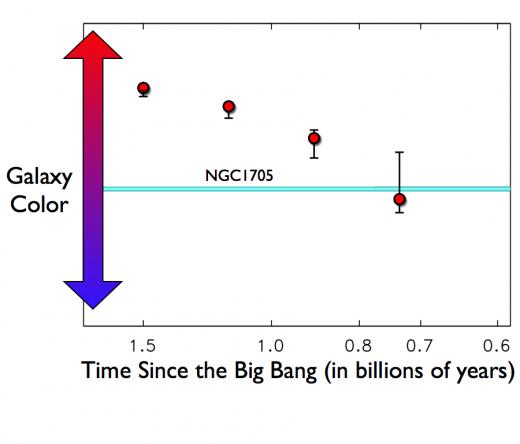
The red circles from left to right represent the measured average color of galaxies at a redshift of 4, 5, 6 and 7, where the bottom axis shows the time since the Big Bang. The light blue bar running through the center of the diagram shows the color of the local galaxy NGC 1705, which contains no dust. When CANDELS astronomers saw that the redshift 7 galaxies in their sample have a similar color as NGC 1705, they derived that those are also dust free. The gradual reddening they observed at lower and lower redshifts reveals that the galaxies are getting dustier with time. Image Credit: S. Finkelstein/CANDELS collaboration
Finkelstein said that previous studies with smaller surveys, including some of his own, appeared to indicate that ancient galaxies were dust free. But CANDELS has found that even at a very early epoch, massive galaxies already contain a lot of dust, in the form of grains of carbon and silicon (in astronomical jargon, “heavy metals”).
“We found something we wouldn’t expect,” Finkelstein said. “Although dust can form quickly, I don’t think many people expected galaxies at only 800 million years after the Big Bang to have a lot of dust. These observations caused us to change our thinking.”
Studying such ancient, and thus faint, galaxies is tricky even for Hubble. Only a miniscule amount of information comes through in the tiny stream of photons they send our way, but their color can be determined. This was the team’s quarry. Galaxy colors are a clue to the amount of dust a galaxy contains: The redder a galaxy appears, the more dust it contains. The bluer it appears, the less dust it contains.
And finding a significant amount of “heavy metal” dust in these early massive galaxies means they must have been forming stars for a while, Finkelstein said. That’s because heavy elements were not created in the Big Bang itself. They are built up over time inside stars, as they fuse lighter elements into heavier ones through nuclear fusion at their cores. When a massive star runs through all of this nuclear fuel, it explodes as a spectacular supernova, spewing these heavy elements into the galaxy. These heavy elements are the building blocks for the dust for which CANDELS was looking.
Steven Finkelstein is an assistant professor in the Department of Astronomy at The University of Texas at Austin. Image Credit: UT-Austin
“These results are very interesting because they tell us that dust does form at early times,” he said. “This is important because the same elements that compose the dust grains are necessary for the formation of planets. Also, we think that dust is a key component in allowing hydrogen gas to form molecules, which is necessary for star formation.”
Additionally, the team found that in between 800 million and 1.5 billion years after the Big Bang, “all galaxies — not just massive ones — get dusty,” Finkelstein said.
This work has him excited about the future, Finkelstein said. “The presence of dust means that a previous generation of stars has lived and died. So, when we can peer back to even farther later this decade with JWST [the James Webb Space Telescope], there should be a lot for us to see!”
Source: The University of Texas at Austin – McDonald Observatory
Read more on Anne’s Astronomy News
Huge Amounts of Water Detected at Dawn of Stellar Birth
October 9th, 2012By Annelies Rhemrev.
ESA’s Herschel space observatory has discovered enough water vapour to fill Earth’s oceans more than 2000 times over in a gas and dust cloud that is on the verge of collapsing into a new Sun-like star.
Herschel’s infrared view of part of the Taurus Molecular Cloud, within which the bright, cold pre-stellar cloud L1544 can be seen at the lower left. It is surrounded by many other clouds of gas and dust of varying density. The Taurus Molecular Cloud is about 450 light-years from Earth and is the nearest large region of star formation. The image covers a field of view of approximately 1 x 2 arcminutes. Image Credit: ESA/Herschel/SPIRE Stars form within cold, dark clouds of gas and dust – ‘pre-stellar cores’ – that contain all the ingredients to make solar systems like our own.
Water, essential to life on Earth, has previously been detected outside of our Solar System as gas and ice coated onto tiny dust grains near sites of active star formation, and in proto-planetary disks capable of forming alien planetary systems.
The new Herschel observations of a cold pre-stellar core in the constellation of Taurus known as Lynds 1544 are the first detection of water vapour in a molecular cloud on the verge of star formation.
More than 2000 Earth oceans-worth of water vapour were detected, liberated from icy dust grains by high-energy cosmic rays passing through the cloud.
“To produce that amount of vapour, there must be a lot of water ice in the cloud, more than three million frozen Earth oceans’ worth,” says Paola Caselli from the University of Leeds, UK, lead author of the paper reporting the results in Astrophysical Journal Letters.
“Before our observations, the understanding was that all the water was frozen onto dust grains because it was too cold to be in the gas phase and so we could not measure it.
Close-up of L1544 with the water spectrum seen by Herschel, taken from the centre of the pre-stellar core. The peak of the graph shows an excess in brightness, or emission, while the trough shows a deficit, or absorption. These characteristics are used to indicate the density and motions of the water molecules within the cloud. Emission arises from molecules that are approaching the center where the new star will form, from the back of the cloud from Herschel’s viewpoint. The amount of emission indicates that these molecules are moving within the densest part of the core, which spans about 1000 Astronomical Units. The absorption signature is due to water molecules in front of the cloud flowing away from the observer towards the center These water molecules are in less dense regions much further away from the center Together, the emission and absorption signatures indicate that the cloud is undergoing gravitational contraction, that is, it is collapsing to form a new star. Herschel detected enough water vapor in L1544 to fill Earth’s oceans more than 2000 times over. Image Credit: ESA/Herschel/SPIRE/HIFI/Caselli et al.
“Now we will need to review our understanding of the chemical processes in this dense region and, in particular, the importance of cosmic rays to maintain some amount of water vapour.”
The observations also revealed that the water molecules are flowing towards the heart of the cloud where a new star will probably form, indicating that gravitational collapse has just started.
“There is absolutely no sign of stars in this dark cloud today, but by looking at the water molecules, we can see evidence of motion inside the region that can be understood as collapse of the whole cloud towards the center,” says Dr Caselli.
“There is enough material to form a star at least as massive as our Sun, which means it could also be forming a planetary system, possibly one like ours.”
Some of the water vapor detected in L1544 will go into forming the star, but the rest will be incorporated into the surrounding disk, providing a rich water reservoir to feed potential new planets.
“Thanks to Herschel, we can now follow the ‘water trail’ from a molecular cloud in the interstellar medium, through the star formation process, to a planet like Earth where water is a crucial ingredient for life,” says ESA’s Herschel project scientist, Göran Pilbratt.
“First detection of water vapour in a pre-stellar core,” by P. Caselli et al. has been accepted for publication in Astrophysical Journal Letters.
Source: The European Space Agency (ESA)
Read more on Anne’s Astronomy News
Rapidly Growing Giant Black Holes Found
October 8th, 2012By Annelies Rhemrev
Scientists at the University of Cambridge have used cutting-edge infrared surveys of the sky to discover a new population of enormous, rapidly growing supermassive black holes in the early Universe. The black holes were previously undetected because they sit cocooned within thick layers of dust. The new study has shown however that they are emitting vast amounts of radiation through violent interactions with their host galaxies. The team publish their results in the journal Monthly Notices of the Royal Astronomical Society.
Markarian 231 is an example of a galaxy with a dusty rapidly growing supermassive black hole located 600 million light years from Earth. The black hole is the very bright source at the centre of the galaxy. Rings of gas and dust can be seen around it as well as “tidal tails” left over from a recent impact with another galaxy. Image Credit: NASA, ESA, the Hubble Heritage Team (STScI/AURA)-ESA/Hubble Collaboration and A. Evans (University of Virginia, Charlottesville/NRAO/Stony Brook University)
The most extreme object in the study is a supermassive black hole called ULASJ1234+0907. This object, located in the direction of the constellation of Virgo, is so far away that the light from it has taken 11 billion years to reach us, so we see it as it appeared in the early universe. The monster black hole has more than 10 billion times the mass of the Sun and 10,000 times the mass of the supermassive black hole in our own Milky Way, making it one of the most massive black holes ever seen.
The research indicates that that there may be as many as 400 such giant black holes in the part of the Universe that we can observe. “These results could have a significant impact on studies of supermassive black holes” said Dr Manda Banerji, lead author of the paper. “Most black holes of this kind are seen through the matter they drag in. As the neighbouring material spirals in towards the black holes, it heats up. Astronomers are able to see this radiation and observe these systems.”
“Although these black holes have been studied for some time, the new results indicate that some of the most massive ones may have so far been hidden from our view.” The newly discovered black holes, devouring the equivalent of several hundred Suns every year, will shed light on the physical processes governing the growth of all supermassive black holes.
Infrared colour image of ULASJ1234+0907 located 11 billion light years from Earth and one of the reddest objects in the sky. This red colour is caused by the enormous amounts of dust within this system. The dust preferentially absorbs bluer light and is responsible for obscuring this supermassive black hole in the visible wavelengths. Image Credit: image created using data from UKIDSS and the Wide-field Infrared Survey Explorer (WISE) observator
Supermassive black holes are now known to reside at the centres of all galaxies. In the most massive galaxies in the Universe, they are predicted to grow through violent collisions with other galaxies, which trigger the formation of stars and provides food for the black holes to devour. These violent collisions also produce dust within the galaxies therefore embedding the black hole in a dusty envelope for a short period of time as it is being fed.
In comparison with remote objects like ULASJ1234+0907, the most spectacular example of a dusty, growing black hole in the local Universe is the well-studied galaxy Markarian 231 located a mere 600 million light years away. Detailed studies with the Hubble Space Telescope have shown evidence that Markarian 231 underwent a violent impact with another galaxy in the recent past. ULASJ1234+0907 is a more extreme version of this nearby galaxy, indicating that conditions in the early Universe were much more turbulent and inhospitable than they are today.
In the new study, the team from Cambridge used infrared surveys being carried out on the UK Infrared Telescope (UKIRT) to peer through the dust and locate the giant black holes for the first time. Prof. Richard McMahon, co-author of the study, who is also leading the largest infrared survey of the sky, said: “These results are particularly exciting because they show that our new infrared surveys are finding super massive black holes that are invisible in optical surveys. These new quasars are important because we may be catching them as they are being fed through collisions with other galaxies. Observations with the new Atacama Large Millimeter Array (ALMA) telescope in Chile will allow us to directly test this picture by detecting the microwave frequency radiation emitted by the vast amounts of gas in the colliding galaxies.”
Source: Royal Astronomical Society (RAS)
Read more on Anne’s Astronomy News
Our Galaxy is Bigger and has More Dark Matter than Thought
October 7th, 2012By Annelies Rhemrev.
A research team, led by Associate Professor Mareki Honma from the National Astronomical Observatory of Japan (NAOJ), has succeeded in precisely determining the astronomical yardstick for the Milky Way galaxy based upon the precise distance measurements with VERA from NAOJ and other advanced radio telescopes. The new findings are that the distance from the Sun to the Galactic center is 26,100 light-years, and that the Galactic rotation velocity in the Solar System is 240 km/s.
The Galactic rotation velocity from this research is higher than that of previously known (220 km/s). This results in the conclusion that the mass of the Galaxy, especially that of dark matter, is about 20% larger than what has been previously considered.

Astronomical yardstick for the Galaxy based upon the precise distance measurements. Left: Image of our galaxy seen from an angel; Rght: Our galaxy seen from above. Image Credit:NAOJ
What is the Milky Way galaxy like?
What is our galaxy like? — How big? How heavy? What shape? We know now that the Galaxy is a spiral galaxy, but precise information including its size, shape, and rotation velocity, has not been made clear yet.
The biggest reason is that we cannot see the Milky Way galaxy from the outside since we stay inside the galaxy. In order to see the whole shape of the galaxy from the inside, it is necessary to precisely measure the distance of each one of the many Galactic objects, and make a “Galactic map” with an overhead view.

Photo: Looking up at the Milky Way Galaxy from VERA. The precise size, weight, and shape of the Mily Way galaxy are still unknown. Image Credit: NAOJ
In that case, trigonometric parallax, or annual parallax, is utilized to measure the distance to an object without any “what if?” assumptions. The trigonometric parallax is the difference in position of an object, which is generated when the Earth orbits around the Sun (see Figure 1). However, the difference is extremely small; even that of Alpha Centauri, the nearest star from the Sun, is one arc-second or less. Therefore, we could not measure any areas beyond 1,000 light-years away from the Solar System by using the annual parallax because of the measurable limit of the parallax. The distance of 1,000 light-years is far smaller than the distance from the Sun to the Galactic center (approximately 26,100 light-years, as mentioned later). This means that measuring the area of our galaxy has been a frontier left for modern astronomy.

Figure 1: Image of the annual parallax measurement. Image Credit: NAOJ
Because the Earth revolves around the Sun over a year, the star position (direction as viewed from the earth) changes slightly in summer and in winter. This change of star positions is called annual parallax. The parallax value is small for distant stars while large for nearby ones. Therefore, the distance to a star can be specified when its parallax value is measured.
Precise Triangulation by Radio Interferometers
VERA (VLBI Exploration of Radio Astrometry), with which the team has continued their research, is a group of four radio interferometers; installed on 20-meter radio telescopes (see Figure 2). This is a project to precisely measure distances to objects with the technology of Very Long Baseline Interferometry (VLBI), and to identify the 3D structure of the Milky Way. The construction of VERA was finished in 2002, and astronomical observations to measure distances to stars have been regularly conducted since 2007.

Figure 2: Layout of VERA telescopes. Simultaneously observing an object with telescopes at four places provides the same performance as a gigantic telescope of approximately 2,300 km in diameter, the same size as Japan. Image Credit: NAOJ
VERA has completed observations of more than 100 radio objects (maser sources) in the Milky Way galaxy, and so far the precise distances and motions of approximately 30 of those objects have been reported. This time, the Galactic yardstick was determined based upon the precise distance measurements with the observation results of 52 objects in total (Figures 3 and 4): 19 star-forming regions (newly-born stars) observed at VERA, and other objects observed by the Very Long Baseline Array (VLBA) of US equipment, and by the European VLBI Network (EVN). In this report, the latest measurement results of VERA were added, making it the world’s first analysis of Galactic structure using more than 50 objects.

Figure 3: The distribution of the observed objects on the position-velocity diagram. The horizontal axis shows the galactic longitude while the vertical axis shows radial velocity. The black dots represent the 52 objects observed so far. The background image in red, green, and blue describes the distribution of molecular gas that leads to the formation of stars; this shows that the observed objects are located along the molecular gas. Image Credit: NAOJ

Figure 4: Image of the Galaxy image seen from above, and the distribution of the precisely measured 52 stars (marked in red). Image Credit: NAOJ
Galactic Yardsticks Precisely Determined
This research successfully managed to determine the Galactic yardsticks precisely: the the distance to the Galactic center from the Solar system, and the Galactic rotation velocity in the Solar System. The distance to the Galactic center is approximately 26,100 light-years +/-1,600 light-years, and the Galactic rotation velocity in the solar system is 240 +/- 14 km/s. (See Figure 5)

Figure 5: An Artist’s rendering of the face-on view of the Milky Way galaxy. The yardsticks of our galaxy determined from this analysis. Image Credit: NAOJ
The following two values were precisely measured: the distance to the Galactic center from the Solar system is 26,100 light-years; the Galactic rotation velocity in the solar system is 240 km/s. From the data on distance and velocity, it has been learned that the Solar System takes approximately 200 million years to revolve around the inner galaxy once.
The value of Galactic rotation velocity from this research is larger than 220 km/s, the one endorsed by the International Astronomical Union (IAU) since 1985. This finding now forces them to change the rotation speed and mass distribution of the Milky Way, as mentioned later. On the other hand, the distance to the Galactic center is almost equal, within an approximately 27,700 light-years margin of error, as that endorsed by the IAU since 1985. However, one of the most important points is that this measurement was directly and more precisely done with the triangulation method and is more precise.
In addition to these yardsticks, it is also confirmed that the Galactic rotation velocity is almost constant between the distances of 10,000 and 50,000 light-years from the Galactic center (see Figure 6).

Figure 6: The rotation velocity of objects in the Galaxy obtained from this analysis. It has been found that a star at any location inside the Galaxy rotates at the almost constant speed of about 240 km/s. Image Credit: NAOJ
More Dark Matter Exists
In general, Galactic rotation velocity is determined by the balance with galactic gravity. Therefore measuring galactic rotation is equal to measuring the galaxy’s mass. When the Milky Way’s mass within the Solar System is measured with the latest Galactic rotation velocity from this research (240 km/s), the amount should increase by no less than approximately 20%. It means that the total amount of dark matter in this area is larger than projected up until now.
The current main theory of dark matter is that it consists of elementary particles. At the moment, some experimental particle physicists have been carrying out dark-matter detection experiments to directly detect dark matter. This research findings also impact any experiments for dark matter search.
The findings of this research emphasize again that the precise measurements of the Milky Way galaxy promoted by VERA are effective to determine the structure of the galaxy. This is also a milestone achievement as the year 2012 is the 10th anniversary of VERA’s completion, and also the turning point of the fifth year from its initial results. In the future, the team will continue observations with VERA to increase the number of objects measured to several hundred in about 10 years. They expect to determine the basic structure of the Milky Way galaxy more precisely.
In addition to VERA, other observations are also available with VLBA and EVN, and with the GAIA satellite expected to launch in 2013. In light of this, our understanding of the Milky Way galaxy should drastically improve in the next ten years.
Source: National Astronomical Observatory of Japan (NAOJ)
Read more on Anne’s Astronomy News
A New Black Hole in our Galaxy Discovered
October 6th, 2012By Annelies Rhemrev
NASA’s Swift satellite recently detected a rising tide of high-energy X-rays from a source toward the center of our Milky Way galaxy. The outburst, produced by a rare X-ray nova, announced the presence of a previously unknown stellar-mass black hole.

Swift satellite discovers rare X-ray Nova and a black hole.Image Credit: NASA
“Bright X-ray novae are so rare that they’re essentially once-a-mission events and this is the first one Swift has seen,” said Neil Gehrels, the mission’s principal investigator, at NASA’s Goddard Space Flight Center in Greenbelt, Md. “This is really something we’ve been waiting for.”
An X-ray nova is a short-lived X-ray source that appears suddenly, reaches its emission peak in a few days and then fades out over a period of months. The outburst arises when a torrent of stored gas suddenly rushes toward one of the most compact objects known, either a neutron star or a black hole.
The rapidly brightening source triggered Swift’s Burst Alert Telescope twice on the morning of Sept. 16, and once again the next day.
Named Swift J1745-26 after the coordinates of its sky position, the nova is located a few degrees from the center of our galaxy toward the constellation Sagittarius. While astronomers do not know its precise distance, they think the object resides about 20,000 to 30,000 light-years away in the galaxy’s inner region.
Ground-based observatories detected infrared and radio emissions, but thick clouds of obscuring dust have prevented astronomers from catching Swift J1745-26 in visible light.
Artist’s impression of a stellar-mass black hole. Image Credit: European Space Agency, NASA and Felix Mirabel (the French Atomic Energy Commission & the Institute for Astronomy and Space Physics/Conicet of Argentina)
The nova peaked in hard X-rays — energies above 10,000 electron volts, or several thousand times that of visible light — on Sept. 18, when it reached an intensity equivalent to that of the famous Crab Nebula, a supernova remnant that serves as a calibration target for high-energy observatories and is considered one of the brightest sources beyond the Solar System at these energies.
Even as it dimmed at higher energies, the nova brightened in the lower-energy, or softer, emissions detected by Swift’s X-ray Telescope, a behavior typical of X-ray novae. By Wednesday, Swift J1745-26 was 30 times brighter in soft X-rays than when it was discovered and it continued to brighten.
“The pattern we’re seeing is observed in X-ray novae where the central object is a black hole. Once the X-rays fade away, we hope to measure its mass and confirm its black hole status,” said Boris Sbarufatti, an astrophysicist at Brera Observatory in Milan, Italy, who currently is working with other Swift team members at Penn State in University Park, Pa.
The black hole must be a member of a low-mass X-ray binary (LMXB) system, which includes a normal, Sun-like star. A stream of gas flows from the normal star and enters into a storage disk around the black hole. In most LMXBs, the gas in the disk spirals inward, heats up as it heads toward the black hole, and produces a steady stream of X-rays.

Artist’s impression of the Swift satellite. Image Credit: NASA
But under certain conditions, stable flow within the disk depends on the rate of matter flowing into it from the companion star. At certain rates, the disk fails to maintain a steady internal flow and instead flips between two dramatically different conditions — a cooler, less ionized state where gas simply collects in the outer portion of the disk like water behind a dam, and a hotter, more ionized state that sends a tidal wave of gas surging toward the center.
“Each outburst clears out the inner disk, and with little or no matter falling toward the black hole, the system ceases to be a bright source of X-rays,” said John Cannizzo, a Goddard astrophysicist. “Decades later, after enough gas has accumulated in the outer disk, it switches again to its hot state and sends a deluge of gas toward the black hole, resulting in a new X-ray outburst.”
This phenomenon, called the thermal-viscous limit cycle, helps astronomers explain transient outbursts across a wide range of systems, from protoplanetary disks around young stars, to dwarf novae — where the central object is a white dwarf star — and even bright emission from supermassive black holes in the hearts of distant galaxies.
Source: The National Aeronautics and Space Administration (NASA)
Read more on Anne’s Astronomy News
Chemistry of Protoplanetary Disks
October 5th, 2012By Annelies Rhemrev
According to the nebular hypothesis, star formation produces a gaseous protoplanetary disk around it, providing the environment and material for planet formation. Studying these systems can generate information regarding how and when planets formed, and is a hot topic in astrophysics.
Artist impression of the Solar System. Image Credit: ESA
Until recently, in depth studying of protoplanetary disks was not possible. However, emerging telescope facilities provide large angular resolution and are expected to revolutionise our current knowledge on the chemistry of protoplanetary disks.
The huge amount of observational information will certainly need theoretical models in order to guarantee a proper interpretation of the data. To this end, the EU project ‘Chemistry in protoplanetary disks’ (Cipdisks) proposed to develop a computational code in order to study the evolution of the chemical composition in the various regions of protoplanetary disks.
An artist’s concept of a very young solar system, with its swirling planet-forming disk.
Image Credit: NASA/JPL-Caltech/T. Pyle
Ultraviolet radiation emitted by the star is known to interact with the gaseous and dusty material of the disk, determining the chemical structure in the disk surface and the emergent spectrum. To address this, scientists developed a code capable of computing the transfer of ultraviolet radiation across the disk including all the discrete transitions due to the most abundant molecular species. This would allow the assessment of the photo-dissociation and photo-ionisation rates of the different species in the disk.
The Cipdisks approach can potentially be used to systematically study the different types of protoplanetary disks and the influence of several stellar and disk parameters on their chemical composition. The detailed study of fundamental processes central to the chemistry of protoplanetary disks, is expected to unravel new information regarding the evolution of our Solar System.
Sources: CORDIS and Phys.Org
Read more on Anne’s Astronomy News
Surprise: Two Black Holes in One Globular Star Cluster
October 4th, 2012By Annelies Rhemrev
An unexpected discovery by an international team of astronomers is forcing scientists to rethink their understanding of the environment in globular star clusters, tight-knit collections containing hundreds of thousands of stars.

Two black holes in a globular star cluster. Image Credit: The University of Southampton
The astronomers, including Dr. Tom Maccarone from the University of Southampton, used the National Science Foundation’s Karl G. Jansky Very Large Array (VLA) in New Mexico, USA to study a globular cluster called Messier 22 (M22), a group of stars more than 10,000 light-years from Earth. They hoped to find evidence of a rare type of black hole in the cluster’s centre called an intermediate-mass black hole, which is more massive than those larger than the Sun’s mass, but smaller than the supermassive black holes found at the cores of galaxies.
However, they found something very surprising – two smaller black holes, which is unusual because most theorists say there should be at most one black hole in the cluster.
Dr. Tom Maccarone, a reader in Astronomy at the University of Southampton, developed the methodology for the study and the surprising result ties in closely to previous research by Tom. He says:
“I had actually suggested several years ago that there were probably black holes lurking among the X-ray sources that had already been seen in globular clusters, and that the one way to pick the black holes sucking gas in, apart from other types of faint X-ray sources, would be to look for the radio emission, but I didn’t expect that this particular cluster would be the best place to look. It was still incredibly exciting to see this result and I’m optimistic that we will find more of these objects in other clusters in the future.”
Black holes, concentrations of mass so dense that not even light can escape them, are left over after very massive stars have exploded as supernovae. In a globular cluster, many of these stellar-mass black holes probably were produced early in the cluster’s 12-billion-year history as massive stars rapidly passed through their life cycles.
Simulations have indicated that these black holes would fall toward the centre of the cluster and then begin a violent gravitational dance with each other, in which all of them, or perhaps all but a single one, would be thrown completely out of the cluster.
“There is supposed to be only one survivor possible,” says Jay Strader of Michigan State University and the Harvard-Smithsonian Center for Astrophysics. “Finding two black holes, instead of one, in this globular cluster definitely changes the picture,” he says.
The astronomers suggest some possible explanations. First, the black holes themselves may gradually work to puff up the central parts of the cluster, reducing the density and thus the rate at which black holes eject each other through their gravitational dance. Alternatively, the cluster may not be as far along in the process of contracting as previously thought, again reducing the density of the core.
The two black holes discovered with the VLA were the first stellar-mass black holes to be found in any globular cluster in our own Milky Way galaxy, and also are the first found by radio, instead of X-ray, observations. Future VLA observations will help us learn about the ultimate fate of black holes in globular clusters.
The scientists published their findings in the latest issue of the scientific journal Nature.
Source: The University of Southampton
Read more on Anne’s Astronomy News
Nearby Planetary System Hosts Comet Crystals, like Our Solar System Does
October 4th, 2012By Annelies Rhemrev
Pristine material that matches comets in our own Solar System has been found in a dust belt around the young star Beta Pictoris by ESA’s Herschel space observatory.
 Close-up of olivine crystals seen inside a meteorite found on Earth that originated from a partly melted Solar System asteroid. The yellow olivine crystals are on the order of a few millimetres to centimetres in size and are held together by an alloy of iron and nickel. In contrast, the olivine crystals found in pristine comets, such as in the material measured in the Beta Pictoris system by ESA’s Herschel space observatory, are iron-poor but magnesium-rich. Image Credit: J. Debosscher, KU Leuven
Close-up of olivine crystals seen inside a meteorite found on Earth that originated from a partly melted Solar System asteroid. The yellow olivine crystals are on the order of a few millimetres to centimetres in size and are held together by an alloy of iron and nickel. In contrast, the olivine crystals found in pristine comets, such as in the material measured in the Beta Pictoris system by ESA’s Herschel space observatory, are iron-poor but magnesium-rich. Image Credit: J. Debosscher, KU Leuven
Twelve-million-year-old Beta Pictoris resides just 63 light-years from Earth and hosts a gas giant planet along with a dusty debris disc that could, in time, evolve into a torus of icy bodies much like the Kuiper Belt found outside the orbit of Neptune in our Solar System.
Thanks to the unique observing capabilities of Herschel, the composition of the dust in the cold outskirts of the Beta Pictoris system has been determined for the first time.
Of particular interest was the mineral olivine, which crystallises out of the protoplanetary disc material close to newborn stars and is eventually incorporated into asteroids, comets and planets.
“As far as olivine is concerned, it comes in different ‘flavours’,” explains Ben de Vries from KU Leuven and lead author of the study reported in Nature.
“A magnesium-rich variety is found in small and primitive icy bodies like comets, whereas iron-rich olivine is typically found in large asteroids that have undergone more heating, or ‘processing’.”
Herschel detected the pristine magnesium-rich variety in the Beta Pictoris system at 15–45 astronomical units (AUs) from the star, where temperatures are around –190ºC.
Infrared view of the Beta Pictoris solar system, obtained by combining data from the ADONIS instrument on ESO’s 3.6 m telescope (outer regions) and the NACO instrument on one of the 8.2 m units of ESO’s Very Large Telescope (inner region), and then subtracting the overpowering glare of the central star. The image shows a planet orbiting at roughly the same distance from Beta Pictoris as Saturn is from our own Sun, and a prominent dust disc in the outer reaches of the system. New observations from ESA’s Herschel space telescope have found magnesium-rich olivine crystals in the disc that likely originated from collisions between comets: the dust shares the same compositional characteristics as in several comets in our Solar System. Furthermore, the observation of these olivines in the outer dust disc suggest that they have been transported from their birthplace close to the central star, since they cannot form under the cold conditions found further out. Image Credits: ESO/A-M. Lagrange et al.
For comparison, Earth lies at 1 AU from our Sun and the Solar System’s Kuiper Belt extends from the orbit of Neptune at about 30 AU out to 50 AU from the Sun.
The Herschel observations allowed astronomers to calculate that the olivine crystals make up around 4% of the total mass of the dust found in this region.
In turn, this finding led them to conclude that the olivine was originally bound up inside comets and released into space by collisions between the icy objects.
“The 4% value is strikingly similar to that of Solar System comets 17P/Holmes and 73P/Schwassmann-Wachmann 3, which contain 2–10% magnesium-rich olivine,” says Dr de Vries.
“Since olivine can only crystallise within about 10 AU of the central star, finding it in a cold debris disc means that it must have been transported from the inner region of the system to the outskirts.”
The ‘radial mixing’ transport mechanism is known from models of the evolution of swirling protoplanetary discs as they condense around new stars.
The mixing is stimulated in varying amounts by winds and heat from the central star pushing materials away, along with temperature differences and turbulent motion created in the disc during planet formation.
“Our findings are an indication that the efficiency of these transport processes must have been similar between the young Solar System and within the Beta Pictoris system, and that these processes are likely independent of the detailed properties of the system,” says Dr de Vries.
Indeed, Beta Pictoris is over one and a half times the mass of our Sun, eight times as bright, and its planetary system architecture is different to our own Solar System today.
“Thanks to Herschel, we were able to measure the properties of pristine material left over from the initial planet-building process in another solar system with a precision that is comparable to what we could achieve in the laboratory if we had the material here on Earth,” says ESA’s Herschel project scientist Göran Pilbratt.
Comet-like mineralogy of olivine crystals in an extra-solar proto-Kuiper Belt by B.L. de Vries et al. is published in Nature, 4 October 2012.
Source: The European Space Agency (ESA)
Read more on Anne’s Astronomy News
The Science Behind those Eye-Popping Northern Lights
October 3rd, 2012By Annelies Rhemrev
Northern night skies have recently been alive with light. Those shimmering curtains get their start about 93 million miles away, on the Sun.

An image of an aurora borealis, and moonrise in the Brooks Range in northern Alaska at the Chandler Shelf in December 2008. Image Credit: guardian.co.uk/Rolf Hicker/Barcroft Media
An aurora borealis (aurora australis in the Southern Hemisphere) is precipitated by explosions on the surface of the Sun, sometimes starting as solar flares, said Robert Nemiroff, an astrophysicist at Michigan Technological University and coauthor of NASA’s Astronomy Picture of the Day website.
These flares release a burst of charged particles, or plasma, into the Solar System. When they come our way, they whack into the Earth’s magnetosphere, which is made up of its own stream of charged particles. That collision causes particles to break free of the magnetosphere and cascade toward the Earth’s magnetic field lines, usually traveling toward the poles.
“The aurorae happen when these high-energy particles bap into atoms and molecules in the Earth’s atmosphere, typically oxygen,” Nemiroff said. Light is emitted as part of the reaction.

Aurora borealis above Keweenaw Bay, near Baraga, Michigan, on Sept. 30, 2012. Sarah Bird photo
Those particles can also wreak havoc. “The plasma cloud can cause the Earth’s magnetic field to fluctuate,” Nemiroff said. “At worst, that can knock out satellites and even power grids.”
Aurorae can happen anytime, but it’s no surprise they are happening now.
“We are nearing the solar maximum, which is when the Sun is at its most active,” he said. Solar maximums come around every 11 years, but no one knows why.
“You can have solar flares and aurorae during the solar minimum, but we get more now because the Sun’s magnetic field is tangled up and poking through the surface, releasing plasma,” said Nemiroff.
Source: Michigan Technological University (MTU)
From: Anne’s Astronomy News http://annesastronomynews.com/
Searching for Water on Asteroid
October 3rd, 2012By Annelies Rhemrev
When the Japanese Hayabusa-2 mission is launched towards asteroid 1999 JU 3 in 2014 to collect surface samples, MASCOT – the Mobile Asteroid Surface Scout – an asteroid lander developed by the German Aerospace Center will be on board. On arrival at the asteroid in 2018, it will be released from the main spacecraft, land on the asteroid, automatically orient itself and ‘hop’ from one measurement site to the next. DLR and the Japanese Aerospace Exploration Agency (JAXA) signed a memorandum of understanding on 1 October 2012, at the International Astronautical Congress in Naples.
An artists rendering of Hayabusa 2 approaching the asteroid 1999 JU3. Image Credit: JAXA
Upon arrival at 1999 JU 3, the Japanese Hayabusa-2 spacecraft will first make a close approach to the asteroid and take measurements of the body’s surface from there. Following this initial cartographical phase, the MASCOT asteroid lander, which is being developed by DLR in collaboration with French space agency (CNES) and JAXA, will be put to work. A mechanism will push the 10-kilogram lander with its four instruments away from the spacecraft. “MASCOT will free-fall to the asteroid from an altitude of around 100 metres,” explained project leader Tra-Mi Ho from the DLR Institute of Space Systems in Bremen. Sensors will then ensure that MASCOT knows which way is up and down, so it can orient itself and, if necessary, correct its attitude.
“There is a special ‘first’ with the Hayabusa-2 mission; it will be the first time that a lander on the surface of an asteroid is able to move around and perform scientific measurements in more than one place,” said Johann-Dietrich Wörner, Chairman of the DLR Executive Board.

MASCOT asteroid lander in microgravity; DLR researchers use parabolic flights to test the MASCOT asteroid lander’s functions in microgravity. MASCOT is due to separate from the Japanese Hayabusa-2 spacecraft above asteroid 1999 JU 3 and fall to the surface. Image Credit: DLR (CC-BY 3.0)
In-situ measurements
While Hayabusa-2 remains above the surface of the asteroid, the four instruments on MASCOT will carry out in-situ investigations into the properties of the surface. The DLR radiometer will measure the temperature, a magnetometer developed by Technische Universität Braunschweig will investigate the magnetisation of the rock, and the spectrometer supplied by CNES will analyse the minerals and rocks that make up the asteroid. The fourth instrument, a DLR camera, will image the fine structure of the surface to enable scientists to learn about the properties, size and shapes of the particles on the surface of the asteroid and map the area around the landing site.
Asteroid 1999 JU 3 is of particular interest to researchers because it consists of 4.5-billion-year-old material that has been altered very little. “Measurements taken from Earth also indicate that the asteroid’s rock may have come into contact with water,” explains Ralf Jaumann, a DLR planetary researcher and scientific spokesman for the experiments on the lander. “MASCOT is due to take measurements of the regolith itself, which will provide reference data about the surface and enable the samples subsequently brought back by Hayabusa-2 to be interpreted in the correct context.” 1999 JU 3 belongs to a type of asteroid that is one of the most common among near-Earth asteroids, so information about its properties will be important in the event that one of these bodies is ever on a collision course with Earth.

Integration of MASCOT; DLR researchers are developing MASCOT, the Mobile Asteroid Surface Scout asteroid lander. The lander will fly to asteroid 1999 JU 3 on board the Japanese Hayabusa-2 spacecraft. Image Credit: DLR (CC-BY 3.0)
At operation for two asteroid-days
Meanwhile, the Hayabusa-2 spacecraft will be using a suction nozzle to collect samples kicked up from the surface by impactor projectiles, and then return these to Earth for laboratory analysis. “MASCOT is the central piece of the puzzle in all the measurements,” said project leader Tra-Mi Ho. “That is, it is the link between the data on the asteroid that the probe collects remotely and the laboratory analyses of the samples.” Once the DLR asteroid lander has carried out all its measurements at one site, it will then ‘hop’ to the next site and start taking measurements there. This mechanism is being developed at the DLR Institute of Robotics and Mechatronics. MASCOT will work on the asteroid for a total of 16 hours – two full asteroid-days.
Source: German Aerospace Center (Deutsches Zentrum für Luft- und Raumfahrt; DLR)
Read more on Annes Astronomu News
Newly Found Comet Could be Brightest Ever Seen
October 2nd, 2012by Annelies Rhemrev
Astronomers are monitoring a newly discovered comet, which is expected to put on a spectacular sky show next year, becoming visible with the unaided eye.
A newly discovered comet called C/2012S1 is expected to be visible to the naked eye next year as it passes close to the Sun. Another comet, Lovejoy, shown here in Dec. 2011, was visible near Earth’s horizon. Image Credit: Dan Burbank/NASA/Associated Press
The celestial visitor, named C/2012S1 (ISON), was detected beyond the orbit of Jupiter last week, and will make its closest approach to the Sun in late November 2013. The comet was discovered by astronomers Vitali Nevski and Artyom Novichonok using the International Scientific Optical Network at the Kislovodsk Observatory in Russia.
Scientists have confirmed that the comet will pass about 1.1 million kilometres above the visible surface of the Sun.
Australian Astronomical Observatory astronomer Malcolm Hartley says it’s impossible to tell if the comet will survive such an extremely close encounter. “Quite often Sun-grazers or Sun-divers simply disintegrate – the head of the comet just evaporates because of the tremendous heat,” says Hartley.
“Last Christmas, Comet Lovejoy was expected to be swallowed up when it got too close to the Sun, yet amazingly survived. This one’s still an unknown, so we’ll have to wait and see.”
Comet Hale-Bopp (C/1995 O1), taken on 1997 April 04. The stars in the image appear slightly elongated, as the camera tracked the comet during the exposure. Image Credit: E. Kolmhofer, H. Raab; Johannes-Kepler-Observatory, Linz, Austria
1,000 times brighter than Venus
Astronomers are speculating that C/2012S1 could be one of the brightest comets ever detected, easily visible in the northern hemisphere for several months as it approaches the Sun. Star watchers located south of the equator may only get a glimpse of its tail.
Some reports have suggested the comet could be as bright as magnitude -11 or even -16, making it more than 1000 times brighter than the planet Venus and almost as bright as a full Moon.
“It’s an unknown,” says Hartley. “It could be a dazzler or a complete washout, that’s the problem with comets like this one.”
If it survives its close encounter with the Sun, C/2012S1 will pass about 60 million kilometres from Earth on 26 December 2013.
Its orbit suggests C/2012S1 originated in the Oort Cloud, a distant comet repository a quarter of the way to the nearest star. But Hartley speculates that it could have previously passed by the Earth.
“There was a great comet in 1680 with an orbit very similar to this comet,” he says. “So there’s a faint possibility that it may be this comet [or part of it] coming back.”
Source: The Australian Broadcasting Corporation
Read more on http://annesastronomynews.com/
Snow And Ice on Oven-Hot Venus?!
October 1st, 2012By Annelies Rhemrev
Venus Express has spied a surprisingly cold region high in the planet’s atmosphere that may be frigid enough for carbon dioxide to freeze out as ice or snow.
This image of the Venus southern hemisphere illustrates the terminator – the transitional region between the dayside (left) and nightside of the planet (right). The south pole is near the terminator, just above the centre of the image. The complex atmosphere that surrounds the planet is also clearly visible. The image was taken at ultraviolet wavelengths by the Venus Monitoring Camera (VMC) on ESA’s Venus Express spacecraft on 15 May 2006, when the spacecraft was flying at about 66 500 km distance from the planet. Image Credits: ESA/MPS, Katlenburg-Lindau, Germany
The planet Venus is well known for its thick, carbon dioxide atmosphere and oven-hot surface, and as a result is often portrayed as Earth’s inhospitable evil twin.
But in a new analysis based on five years of observations using ESA’s Venus Express, scientists have uncovered a very chilly layer at temperatures of around –175ºC in the atmosphere 125 km above the planet’s surface.
The curious cold layer is far frostier than any part of Earth’s atmosphere, for example, despite Venus being much closer to the Sun.
The discovery was made by watching as light from the Sun filtered through the atmosphere to reveal the concentration of carbon dioxide gas molecules at various altitudes along the terminator – the dividing line between the day and night sides of the planet.
Armed with information about the concentration of carbon dioxide and combined with data on atmospheric pressure at each height, scientists could then calculate the corresponding temperatures.
“Since the temperature at some heights dips below the freezing temperature of carbon dioxide, we suspect that carbon dioxide ice might form there,” says Arnaud Mahieux of the Belgian Institute for Space Aeronomy and lead author of the paper reporting the results in the Journal of Geophysical Research.

The temperature profile along the terminator for altitudes of 70–160 km above the surface of Venus. The values were derived from the volume density of carbon dioxide molecules measured during solar occultation experiments by Venus Express’ SOIR instrument. The graphic provides the average range of values calculated from 59 measurements taken along the terminator from 88ºN to 77ºS, during different orbits between 2006 and 2011. The new report finds a prominent cold layer at 125 km sandwiched between two comparatively warmer layers at around 100 km and 140 km. At some locations, the temperatures occasionally dip below the freezing temperature of carbon dioxide, which suggests that carbon dioxide ice or snow could exist at these altitudes. Image Credit: ESA/AOES–A.V. Bernus
Clouds of small carbon dioxide ice or snow particles should be very reflective, perhaps leading to brighter than normal sunlight layers in the atmosphere.
“However, although Venus Express indeed occasionally observes very bright regions in the Venusian atmosphere that could be explained by ice, they could also be caused by other atmospheric disturbances, so we need to be cautious,” says Dr Mahieux.
The study also found that the cold layer at the terminator is sandwiched between two comparatively warmer layers.
“The temperature profiles on the hot dayside and cool night side at altitudes above 120 km are extremely different, so at the terminator we are in a regime of transition with effects coming from both sides.
“The night side may be playing a greater role at one given altitude and the dayside might be playing a larger role at other altitudes.”
Similar temperature profiles along the terminator have been derived from other Venus Express datasets, including measurements taken during the transit of Venus earlier this year.
Models are able to predict the observed profiles, but further confirmation will be provided by examining the role played by other atmospheric species, such as carbon monoxide, nitrogen and oxygen, which are more dominant than carbon dioxide at high altitudes.
“The finding is very new and we still need to think about and understand what the implications will be,” says Håkan Svedhem, ESA’s Venus Express project scientist.
“But it is special, as we do not see a similar temperature profile along the terminator in the atmospheres of Earth or Mars, which have different chemical compositions and temperature conditions.”
Source: The European Space Agency (ESA)
Yellow Supergiant Became a Supernova
October 1st, 2012By Annelies Rhemrev
A group of researchers led by Melina Bersten (Kavli IPMU) has presented evidence that the yellow supergiant (YSG) star found at the location of supernova SN 2011dh in the famous nearby galaxy M51 (the Whirlpool Galaxy) was indeed the SN progenitor, as well as produced a self-consistent model to explain how a star of such characteristics exploded. In their model, the exploding YSG star was a member of a close binary system. The authors further predict the detection of the companion star as a definitive test of their hypothesis. Their paper has been published in The Astrophysical Journal.
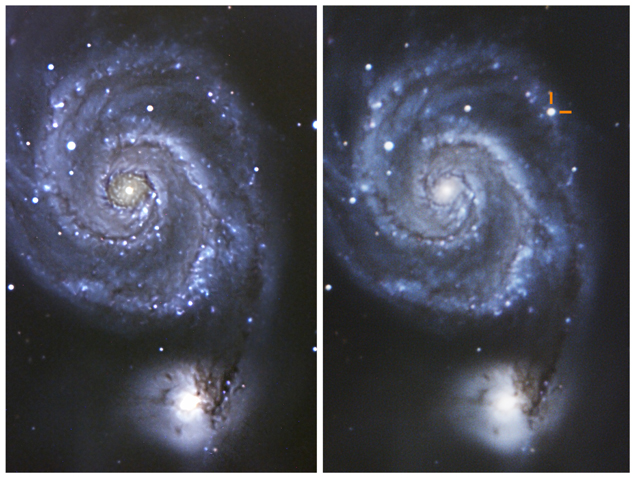
Figure 1. M51 Galaxy before (left) and after (right) the eruption of SN 2011dh. The image on the left was taken in 2009, and on the right July 8th, 2011. Image Credit: Conrad Jung
The nature and diversity of the progenitor star or progenitor system of core-collapse supernovae is an important and open question in the field of astrophysics. It is believed that most massive stars explode when the stars become red supergiants, or, alternatively, blue compact stars (so-called Wolf-Rayet stars). Recent detections of a yellow supergiant star as a possible supernova progenitor have posed serious questions on our understanding of the evolution of massive stars.
Due to its proximity, SN 2011dh in M51 was one of the brightest and best studied supernovae of 2011(Figure 1). It was classified as a type IIb supernova, that is, it showed hydrogen lines in the spectrum at early times, and then evolved into a helium-dominated spectrum. This is indicative of a progenitor star that has lost most of its hydrogen-rich envelope prior to the explosion.
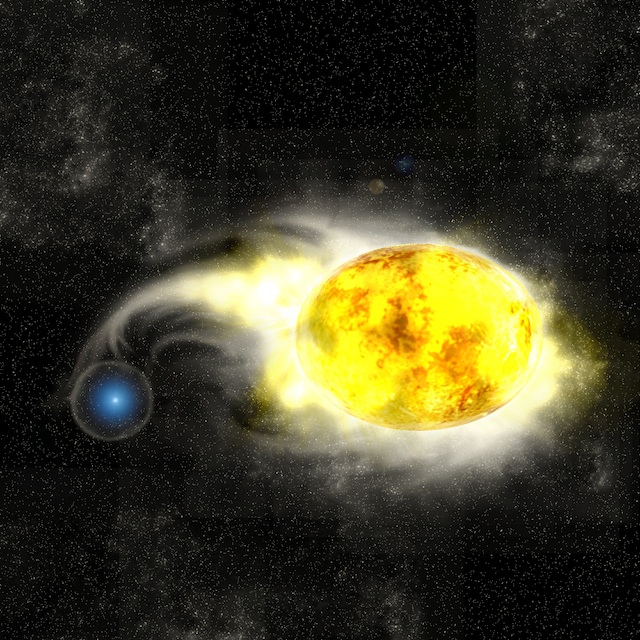
Figure 2. Artist’s conception of the progenitor system of SN 2011dh. The system consists of a blue star and a yellow supergiant. Image Credit: Kavli IPMU/Aya Tsuboi
By searching through archival images obtained with the Hubble Space Telescope before the supernova explosion, two groups of astronomers independently detected a source at a location closely matching that of the supernova. Photometry of this pre-supernova source is compatible with a YSG star. If it is indeed the progenitor of the supernova, the question arises as to how such a star would undergo an explosion. Stellar evolution models predict that stars massive enough to produce a supernova explosion by core collapse should end their lives as red supergiants —for the lower mass range— or as a compact blue star —for the larger masses.
The YSG phase is an intermediate, short-lived stage in evolutionary models of single stars, during which no supernova explosion is expected to occur. Moreover, based on early optical emission and radio observations of SN2011dh, some authors claimed that the actual progenitor must have been a compact object. Therefore, the detected YSG star could have been a companion of the exploded star, or even an unrelated object that matched the projected supernova location by chance.
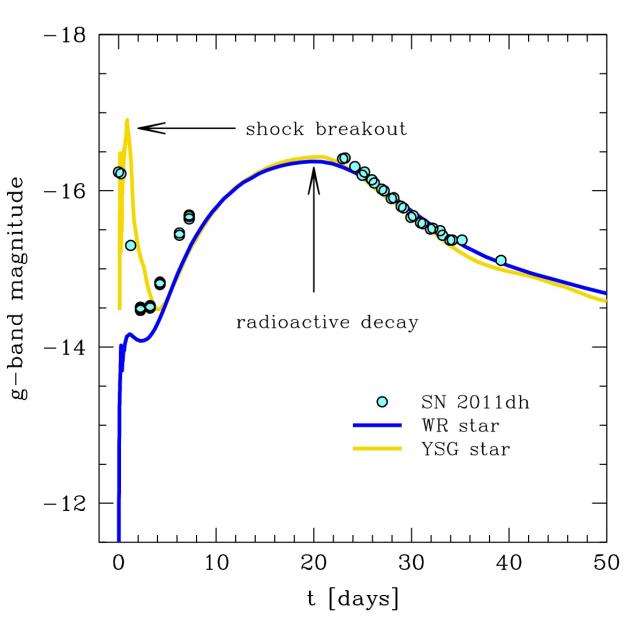
Figure 3. Theoretical light curve for a yellow supergiant (yellow) and blue compact (blue) progenitor compared with the observations of SN 2011dh (cyan points). From the figure it is clear that the progenitor of SN 2011dh needs to be a yellow supergiant in order to reproduce the observation. Image Credit: Kavli Institute for the Physics and Mathematics of the Universe
In this work the authors have presented evidence that the progenitor was an extended object, of radius compatible with that of a YSG star(Figure 2), contrary to the previous theoretical models. This was done by modeling the early-time optical emission using hydrodynamical calculations. As shown in Figure 3, the observed light curve is reproduced only from the YSG star hypothesis. Now, these findings led to two new questions: (1) how did the star lose most of its hydrogen envelope?, and (2) how could a YSG star of those characteristics explode?
Related with question (1), there are two main mechanisms proposed for stars to get rid of their outer layers: strong winds, and mass transfer in interacting binary systems. For the former mechanism, it is believed that the star should have a mass at the time of birth larger than approximately 25 times the mass of the Sun for the wind to be strong enough. Hydrodynamical models, however, set a strong constraint on the mass of the progenitor star. They found that its core could have not been more massive than 8 times the mass of the Sun, which implies that the initial mass of the entire star was less than 25 times the mass of the Sun. With this possibility ruled out, they tested the alternative of a system in which the progenitor transfered mass to a close companion, thereby losing most of its outer envelope. The binary scenario has the advantage of introducing a natural mechanism for lower mass stars to expell their envelopes.
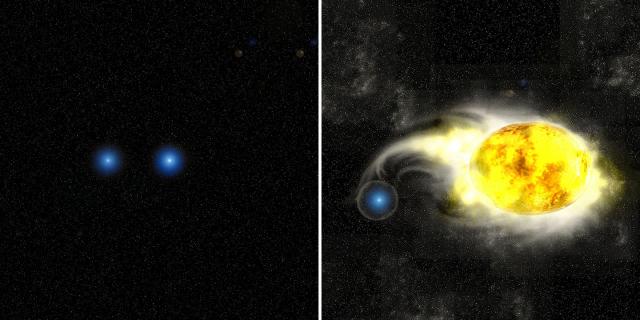
Figure 4. Artist’s conception of binary systems of (left:) two blue stars and (right:) a blue star and a yellow supergiant star.Image Credit: Kavli IPMU/Aya Tsuboi
With the aim of solving both questions above, Bersten’s team carried out stellar evolution calculations for a system of two massive stars in a close orbit, in which phases of mass transfer occur. By assuming a system of stars with initial masses of 16 and 10 times the mass of the Sun, and an initial period of 125 days(Figure 4), they were able to obtain a configuration for the mass-donor star —the one that eventually explodes— that matches closely the observations of the YSG object in the pre-supernova images and has a core mass that is consistent with their hydrodynamic modeling. Moreover, the amount of hydrogen left in the envelope of the exploding star was in the correct range to classify the supernova as type IIb. This is in contrast to a single star that evolves to a red supergiant(Figure 5).
Finally, the binary models predict that the accreting companion object should be a massive, blue star at the moment of the supernova explosion. Because of its high surface temperature, the companion star should emit mostly in the ultraviolet range, with negligible contribution to the total flux of the system in the optical range. The companion was faint enough so that it was not be detected in the pre-supernova images of the space telescope. Their calculations thus predict that in the near future, once the supernova has faded enough, the companion could be discovered with deep observations in the blue range of the spectrum. This would constitute a definitive test for the validity of the model.
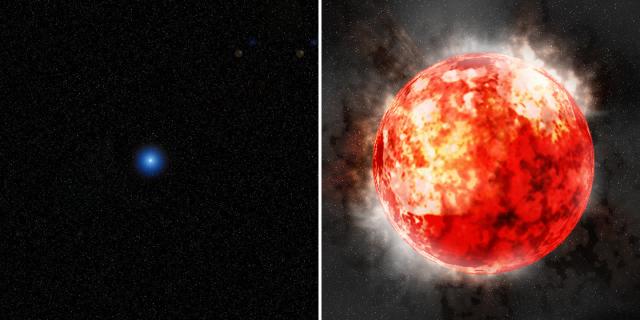
Figure 5. Artist’s conception of (left:) a single blue star and (right:) a red supergiant star. A single blue star is considered to become a red supergiant before a supernova explosion. Image Credit: Kavli IPMU/Aya Tsuboi
“The present results reveal the necessity and importance of further studying the evolution and explosion of binary stars,” Bersten, the first author of the paper saids,”I look forward to the observation that will confirm our prediction.”
The publication: Title: “The Type IIb Supernova 2011dh from a Supergiant Progenitor”; Melina C. Bersten, Omar G. Benvenuto, Ken’ichi Nomoto et al. 2012 ApJ 757 31 doi:10.1088/0004-637X/757/1/31
Source: Kavli Institute for the Physics and Mathematics of the Universe
Curiosity Finds Old Streambed on Mars
September 30th, 2012NASA’s Curiosity rover mission has found evidence a stream once ran vigorously across the area on Mars where the rover is driving. There is earlier evidence for the presence of water on Mars, but this evidence — images of rocks containing ancient streambed gravels — is the first of its kind.

NASA’s Curiosity rover found evidence for an ancient, flowing stream on Mars at a few sites, including the rock outcrop pictured here, which the science team has named “Hottah” after Hottah Lake in Canada’s Northwest Territories. Image Credit: NASA/JPL-Caltech/MSSS
Scientists are studying the images of stones cemented into a layer of conglomerate rock. The sizes and shapes of stones offer clues to the speed and distance of a long-ago stream’s flow.
“From the size of gravels it carried, we can interpret the water was moving about 3 feet per second, with a depth somewhere between ankle and hip deep,” said Curiosity science co-investigator William Dietrich of the University of California, Berkeley. “Plenty of papers have been written about channels on Mars with many different hypotheses about the flows in them. This is the first time we’re actually seeing water-transported gravel on Mars. This is a transition from speculation about the size of streambed material to direct observation of it.”
This map shows the path on Mars of NASA’s Curiosity rover toward Glenelg, an area where three terrains of scientific interest converge. Image Credit: NASA/JPL-Caltech/Univ. of Arizona
The finding site lies between the north rim of Gale Crater and the base of Mount Sharp, a mountain inside the crater. Earlier imaging of the region from Mars orbit allows for additional interpretation of the gravel-bearing conglomerate. The imagery shows an alluvial fan of material washed down from the rim, streaked by many apparent channels, sitting uphill of the new finds.
The rounded shape of some stones in the conglomerate indicates long-distance transport from above the rim, where a channel named Peace Vallis feeds into the alluvial fan. The abundance of channels in the fan between the rim and conglomerate suggests flows continued or repeated over a long time, not just once or for a few years.

This image shows the topography, with shading added, around the area where NASA’s Curiosity rover landed on Aug. 5 PDT (Aug. 6 EDT). Image Credit: NASA/JPL-Caltech/UofA
The discovery comes from examining two outcrops, called “Hottah” and “Link,” with the telephoto capability of Curiosity’s mast camera during the first 40 days after landing. Those observations followed up on earlier hints from another outcrop, which was exposed by thruster exhaust as Curiosity, the Mars Science Laboratory Project’s rover, touched down.
“Hottah looks like someone jack-hammered up a slab of city sidewalk, but it’s really a tilted block of an ancient streambed,” said Mars Science Laboratory Project Scientist John Grotzinger of the California Institute of Technology in Pasadena.

This false-color map shows the area within Gale Crater on Mars, where NASA’s Curiosity rover landed on Aug. 5, 2012 PDT (Aug. 6, 2012 EDT). Image Credit: NASA/JPL-Caltech/ASU
The gravels in conglomerates at both outcrops range in size from a grain of sand to a golf ball. Some are angular, but many are rounded.
“The shapes tell you they were transported and the sizes tell you they couldn’t be transported by wind. They were transported by water flow,” said Curiosity science co-investigator Rebecca Williams of the Planetary Science Institute in Tucson, Ariz.

This image from NASA’s Curiosity Rover shows a high-resolution view of an area that is known as Goulburn Scour, a set of rocks blasted by the engines of Curiosity’s descent stage on Mars. Image Credit: NASA/JPL-Caltech/MSSS
The science team may use Curiosity to learn the elemental composition of the material, which holds the conglomerate together, revealing more characteristics of the wet environment that formed these deposits. The stones in the conglomerate provide a sampling from above the crater rim, so the team may also examine several of them to learn about broader regional geology.
The slope of Mount Sharp in Gale Crater remains the rover’s main destination. Clay and sulfate minerals detected there from orbit can be good preservers of carbon-based organic chemicals that are potential ingredients for life.

This image shows exposed bedrock made up of smaller fragments cemented together, or what geologists call a sedimentary conglomerate. Broken surfaces of the outcrop have rounded, gravel clasts, such as the one circled in white, which is about 1.2 inches (3 centimeters) across. Erosion of the outcrop results in gravel clasts that protrude from the outcrop and ultimately fall onto the ground, creating the gravel pile at left. Image Credit: NASA/JPL-Caltech/MSSS
“A long-flowing stream can be a habitable environment,” said Grotzinger. “It is not our top choice as an environment for preservation of organics, though. We’re still going to Mount Sharp, but this is insurance that we have already found our first potentially habitable environment.”
During the two-year prime mission of the Mars Science Laboratory, researchers will use Curiosity’s 10 instruments to investigate whether areas in Gale Crater have ever offered environmental conditions favorable for microbial life.

This set of images compares the Link outcrop of rocks on Mars (left) with similar rocks seen on Earth (right). Image Credit: NASA/JPL-Caltech/MSSS and PSI
Source: Jet Propulsion Laboratory (JPL)
Planets Around Pulsars – Can They Support Life?
September 30th, 2012Pulsars are among the most extreme stars in the Universe: dense balls of matter which are heavier than the Sun, yet only a few tens of kilometres in diameter. They rotate rapidly (up to several hundred revolutions per second) and flash like lighthouse beacons – hence the name, which is short for pulsating star. And yet despite these exotic properties, pulsars are like our Sun in one way at least: two have been observed to be home to planetary systems.

This artist’s impression shows the planetary system around pulsar PSR B1257+12, one of two pulsars known to be host to at least one planet. Research by Fabrice Mottez (Paris Observatory) finds that planets around pulsars may have powerful electromagnetic wakes around them. These wakes have implications both for how pulsar planets form, and for how they can be detected. Image Credit: NASA/JPL-Caltech/R. Hurt (SSC)
This work, presented to the European Planetary Science Congress in Madrid on Friday 28 September, Fabrice Mottez (Paris Observatory) makes a series of predictions about the properties of planetary systems around pulsars. His team’s work has implications both for how to discover these planets, and for their formation, evolution and properties.
“Pulsars and their planetary systems work a bit like giant electric generators,” says Mottez. “If the conditions are right, the magnetic field and stellar wind of the pulsar can interact with planets and create a powerful electromagnetic wake around the planets.”
This phenomenon may be visible from Earth, which would provide a new method of detecting planets around pulsars. But it has even greater importance for how pulsar planet systems evolve.
When objects such as stars or planets radiate, they lose energy. And while the forces unleashed by the wakes around pulsar planets are not large enough to have a major effect on the planets’ orbits, they are expected to have much more profound effects on smaller bodies like asteroids and comets.

This image, which combines data from the Hubble Space Telescope (visible light), Spitzer Space Telescope (infrared) and Chandra X-ray Observatory (X-rays) shows the Crab Pulsar. The X-ray emissions (in blue) show the location of high-energy phenomena around the rapidly spinning star. The visible and infrared light (shown in red) traces the location of debris thrown out by the supernova that destroyed the Crab Pulsar’s progenitor star. Although it is not known whether the Crab Pulsar has planets, it is thought that the debris surrounding pulsars can form planetary systems. Work by Fabrice Mottez (Paris Observatory) shows how electromagnetic phenomena in pulsar systems can greatly affect the motion of small bodies like asteroids and comets that form the building blocks of planets. Image Credit: X-Ray: NASA/CXC/J.Hester (ASU); Optical: NASA/ESA/J.Hester & A.Loll (ASU); Infrared: NASA/JPL-Caltech/R.Gehrz (Univ. Minn.)
“Depending on the direction of their orbits, asteroids and comets could be thrown out into distant orbits or dragged down onto the pulsar’s surface. Even for objects as big as a kilometre in diameter, this could happen in less than 10,000 years, which is very rapid on astronomical timescales,” says Mottez.
While these phenomena have only a small impact on the orbital motions of planets, Mottez’s work is an important step towards better understanding how circumpulsar planets may form.
Pulsars are the dense cores leftover from large stars after they explode in a supernova. Although supernovae are extremely violent, it is thought that planets surrounding an exploding star can survive the blast, albeit in a heavily disrupted orbit. However, planetary survivors like these are not the only kind of planet that could in theory exist around a pulsar.
Planets form from discs of matter that gradually accrete around stars, usually when the star has just been born. However, it is thought that the debris thrown out by supernovae could provide material that triggers a second burst of planet formation around pulsars, shortly after the explosion.
The disruptive effects of the electromagnetic wake on small objects could have profound consequences for the formation of such second generation planets.
Source: Europlanet



